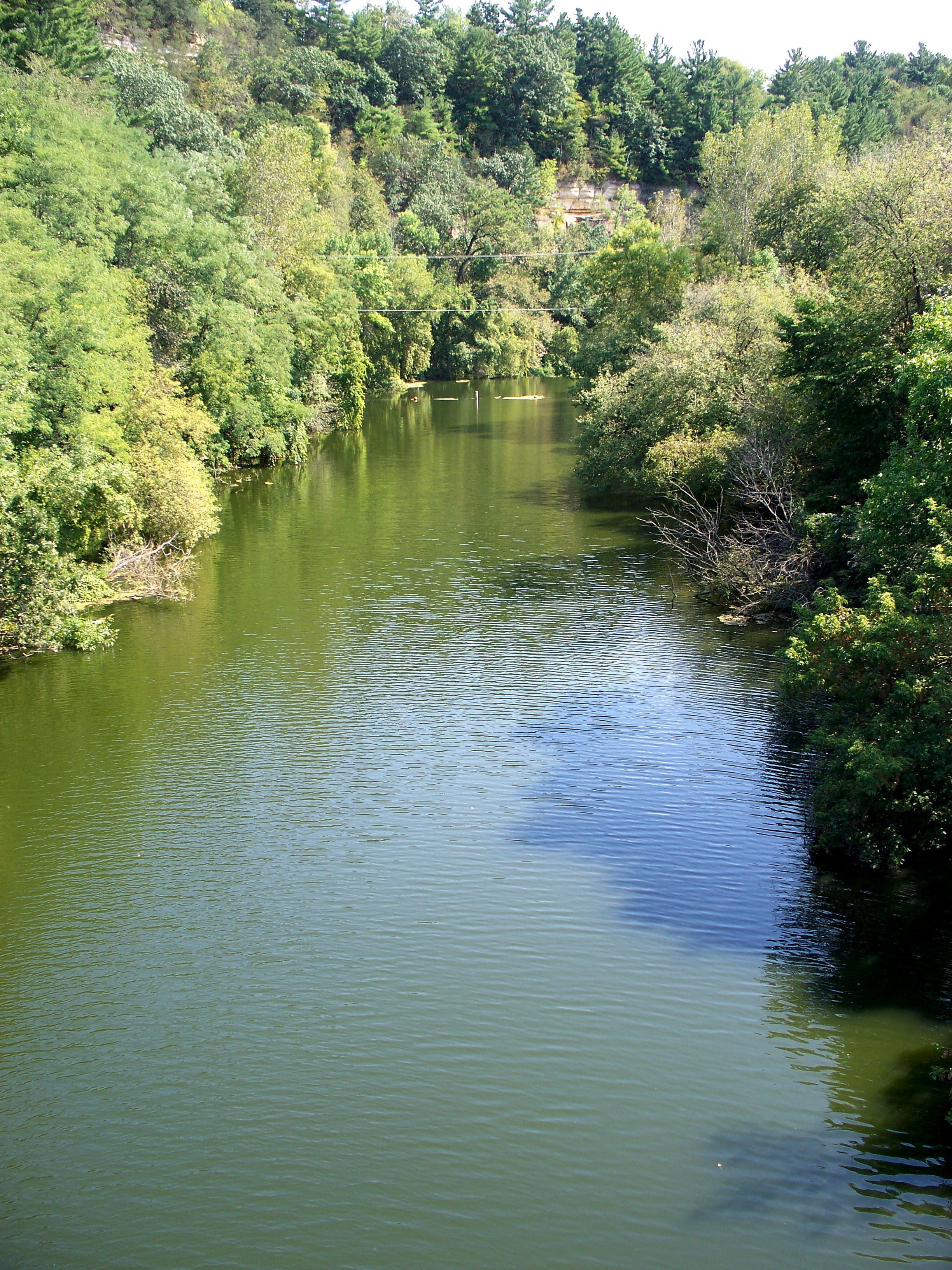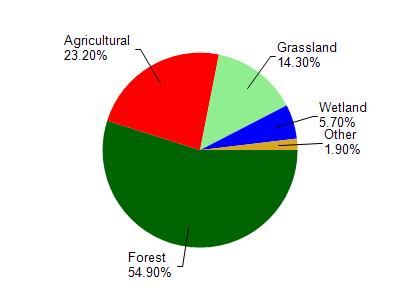
11 Miles
7.04 - 18.04
Cool-Cold Mainstem, Cool-Warm Mainstem, Coldwater
2020
Poor
High Phosphorus Levels
Total Phosphorus
Trempealeau
Yes
No
Yes
Fish and Aquatic Life
Overview
Beaver Creek begins at the confluence of the North and South Forks of Beaver Creek at Ettrick. It flows approximately 15 miles to the Black River. Lake Marinuka, an impoundment of Beaver Creek in Galesville, traps sand and sediment transported from the watershed. Below the lake, the substrate primarily consists of gravel and rubble. In the portion of Beaver Creek below the dam, streambanks are largely protected by wetlands. Beaver Creek is a Class II trout stream from Ettrick to Lake Marinuka, and a forage fishery below the dam to the Black River. Tributaries to Beaver Creek above the lake carry a considerable amount of sediment to the main stem due to their high gradients and exposed streambanks (WDNR, 1986). Fishery surveys conducted in 1985 and again in 1996 indicated an increase in trout densities. However no young of year trout were documented. The stocking records indicate the number of fish stocked prior to the 1996 surveys was 117% higher than in 1985. The higher trout densities found in 1996 are probably a result of higher stocking rates (Hazuga).
From: Koperksi, Cindy. 1999. Black River Water Quality Management Plan (draft). Wisconsin Department of Natural Resources, Madison, WI.
Date 1999
Author Cynthia Koperski
Impaired Waters
The 2018 assessments of Beaver Creek (WBIC 1677500, Marinuka Lake to the forks (at Ettrick)) showed impairment by phosphorus; new total phosphorus sample data overwhelmingly exceeded the 2018 WisCALM listing criteria for the Fish and Aquatic Life use. However, available biological data did not indicate impairment. Available macroinvertebrate and new fish sample data were assessed, but no macroinvertebrate or fish Index of Biotic Integrity (IBI) scored in the "poor" condition category. Based on the most updated information, this water was proposed for the impaired waters list.
Date 2017
Author Ashley Beranek
Condition
Wisconsin has over 84,000 miles of streams, 15,000 lakes and milllions of acres of wetlands. Assessing the condition of this vast amount of water is challenging. The state's water monitoring program uses a media-based, cross-program approach to analyze water condition. An updated monitoring strategy (2015-2020) is now available. Compliance with Clean Water Act fishable, swimmable standards are located in the Executive Summary of Water Condition in 2018. See also the 'monitoring and projects' tab.
Reports
Recommendations
Citizen-Based Stream Monitoring
Collect chemical, physical, and/or biological water quality data to assess the current overall stream health. The data can inform management decisions and may be used to identify impaired waters for biennial lists.
Citizen-Based Stream Monitoring
Collect chemical, physical, and/or biological water quality data to assess the current overall stream health. The data can inform management decisions and may be used to identify impaired waters for biennial lists.
Management Goals
Wisconsin's Water Quality Standards provide qualitative and quantitative goals for waters that are protective of Fishable, Swimmable conditions [Learn more]. Waters that do not meet water quality standards are considered impaired and restoration actions are planned and carried out until the water is once again fishable and swimmable
Management goals can include creation or implementation of a Total Maximum Daily Load analysis, a Nine Key Element Plan, or other restoration work, education and outreach and more. If specific recommendations exist for this water, they will be displayed below online.
Monitoring
Monitoring the condition of a river, stream, or lake includes gathering physical, chemical, biological, and habitat data. Comprehensive studies often gather all these parameters in great detail, while lighter assessment events will involve sampling physical, chemical and biological data such as macroinvertebrates. Aquatic macroinvertebrates and fish communities integrate watershed or catchment condition, providing great insight into overall ecosystem health. Chemical and habitat parameters tell researchers more about human induced problems including contaminated runoff, point source dischargers, or habitat issues that foster or limit the potential of aquatic communities to thrive in a given area. Wisconsin's Water Monitoring Strategy was recenty updated.
Grants and Management Projects
Monitoring Projects
| WBIC | Official Waterbody Name | Station ID | Station Name | Earliest Fieldwork Date | Latest Fieldwork Date | View Station | View Data |
|---|
| 1679200 | Unnamed | 10020895 | Beaver Creek at Hwy 53 | 5/14/2007 | 1/1/2015 | Map | Data |
| 1677500 | Beaver Creek | 10020895 | Beaver Creek at Hwy 53 | 5/14/2007 | 1/1/2015 | Map | Data |
| 1677500 | Beaver Creek | 10013424 | Beaver Creek-Hwy 53 Crossing Upstream 1575 ft | 1/1/2015 | 1/1/2015 | Map | Data |
| 1677500 | Beaver Creek | 10008420 | Beaver Creek Station 3 -Leque Rd Crossing | | | Map | Data |
| 1677500 | Beaver Creek | 10008405 | Beaver Creek - Starts 2000' Ds Of Hwy 53 | | | Map | Data |
| 1677500 | Beaver Creek | 10020475 | Beaver Creek-Crystal Valley (Daulton Rd) Bridge Crossing | 10/12/2006 | 10/15/2019 | Map | Data |
| 1677500 | Beaver Creek | 10031974 | Beaver Creek at Arctic Springs Supper Club | | | Map | Data |
| 1677500 | Beaver Creek | 623120 | Marinuka Lake Inlet - Marinuka Lake Inlet | 7/25/1973 | 10/7/1974 | Map | Data |
| 1677500 | Beaver Creek | 623113 | Beaver Creek - Sth 53 Sec 21 T15n R8w | | | Map | Data |
| 1679200 | Unnamed | 10013424 | Beaver Creek-Hwy 53 Crossing Upstream 1575 ft | 1/1/2015 | 1/1/2015 | Map | Data |
| 1677500 | Beaver Creek | 10021971 | Beaver Ck Stock Traux Rd | 1/1/2015 | 10/26/2020 | Map | Data |
| 1677500 | Beaver Creek | 10013447 | Beaver Creek-Mouth Of French Crk. Downstream | | | Map | Data |
|

Watershed Characteristics
Beaver Creek is located in the Beaver Creek and Lake Marinuka watershed which is 160.31 mi². Land use in the watershed is primarily forest (54.90%), agricultural (23.20%) and a mix of grassland (14.30%) and other uses (7.60%). This watershed has 375.97 stream miles, 229.76 lake acres and 3,765.47 wetland acres.
Nonpoint Source Characteristics
This watershed is ranked Not Available for runoff impacts on streams, Not Available for runoff impacts on lakes and Medium for runoff impacts on groundwater and therefore has an overall rank of Medium. This value can be used in ranking the watershed or individual waterbodies for grant funding under state and county programs.However, all waters are affected by diffuse pollutant sources regardless of initial water quality. Applications for specific runoff projects under state or county grant programs may be pursued. For more information, go to surface water program grants.
Beaver Creek is considered a Cool-Cold Mainstem, Cool-Warm Mainstem, Coldwater under the state's Natural Community Determinations.
Natural communities (stream and lake natural communities) represent model results and DNR staff valiation processes that confirm or update predicted conditions based on flow and temperature modeling from historic and current landscape features and related variables. Predicated flow and temperatures for waters are associated predicated fish assemblages (communities). Biologists evaluate the model results against current survey data to determine if the modeled results are corect and whether biological indicators show water quaity degradation. This analysis is a core component of the state's resource management framework. Wisconsin's Riverine Natural Communities.
Cool (Cold-Transition) Mainstem streams are moderate-to-large but still wadeable perennial streams with cold to cool summer temperatures. Coldwater fishes are common to uncommon, transitional fishes are abundant to common, and warm water fishes are uncommon to absent. Headwater species are common to absent,
mainstem species are abundant to common, and river species are common to absent.